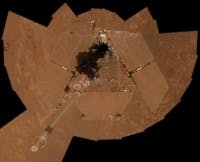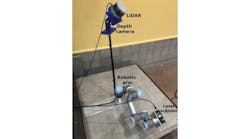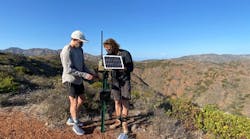On January 25, 2004, the Mars Rover Opportunity landed on Mars and has been operating on the red planet since. Almost ten years later to the day, Opportunity used its panoramic camera (Pancam) to capture an image of itself and sent it back to Earth.
The Pancam consists of a pair of color stereo CCD cameras, which image the surface and sky of Mars. The CCD image sensor chips—which have a 1,024 x 1,024 active pixel area—were designed by NASA’s Jet Propulsion Laboratory and manufactured at the Teledyne DALSA (DALSA, at the time), semiconductor-wafer-production facility in Bromont, Quebec, Canada. The Pancam Mast Assembly enables the cameras to rotate a full 360° to obtain panoramic views of the Martian landscape. Pancam’s cameras weigh only 270 grams (about 9 ounces), but can generate panoramic image mosaics as large as 4,000 x 24,000.
Each of the lenses on the Pancam has a filter wheel which enables multispectral imaging—allowing scientists to learn more about the minerals found on Mars. Blue and infrared solar filters facilitate the camera to image the sun, and this, along with images of the sky at different wavelengths, helps to determine the orientation of the rover and provide information about the dust in the atmosphere of Mars.
The image, or as PetaPixel is calling it, "selfie"—was taken during the interval of January 3 to January 6, a few days after winds removed some of the dust that had been accumulating on the rover’s solar panels. Opportunity’s initial mission was planned to last only three months, but 10 years later, it is still active and transmitting images.
View more information on Mars Exploration Rovers.
View the high-resolution image.
Also check out:
Keck I telescope captures image of rare brown dwarf
Spectrograph finds three new planets in Messier 67 star cluster
Gemini Planet Imager captures photo of planet 63 light years from Earth
Share your vision-related news by contacting James Carroll, Senior Web Editor, Vision Systems Design
To receive news like this in your inbox, click here.
Join our LinkedIn group | Like us on Facebook | Follow us on Twitter | Check us out on Google +






